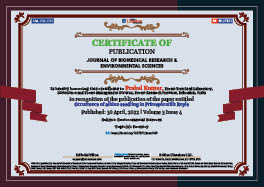Prabal Kumar*, Devendra Kumar and Sanjay Singh
Volume3-Issue4
Dates: Received: 2022-04-14 | Accepted: 2022-04-29 | Published: 2022-04-30
Pages: 485-487
Abstract
Albinism in plants is characterized by partial or complete loss of chlorophyll pigments and incomplete differentiation of chloroplast membranes. This is a very common problem encountered in interspecific crosses and tissue culture experiments including anther culture and generation of doubled haploids. This impairs photosynthesis and the plants eventually die at a young stage without reaching maturity. Environmental conditions such as light, temperature, media composition and culture conditions may key factors in determining the frequency of albino plant formation. This short communication reports the first instance of albinism recorded in Prinsepia utilis Royle. An albino seedling was observed during the standardization of nursery techniques.
FullText HTML
FullText PDF
DOI: 10.37871/jbres1469
Certificate of Publication

Copyright
© 2022 Prabal Kumar, et al. Distributed under Creative Commons CC-BY 4.0
How to cite this article
Prabal Kumar, Devendra Kumar, Sanjay Singh. Occurrence of albino seedling in Prinsepia utilis Royle. J Biomed Res Environ Sci. 2022 Apr 30; 3(4): 485-487. doi: 10.37871/jbres1469, Article ID: JBRES1469, Available at: https://www.jelsciences.com/articles/jbres1469.pdf
Subject area(s)
References
- Maikhuri RK. Prinsepia utilis (bhekl): A promising wild edible oil shrub of higher Himalaya-a case study in Urgain valley of Garhwal Himalaya. Plant genetic resources newsletter. 1995;1(14):115-123. https://tinyurl.com/3m3nsehd
- Maithani GP, Bhauguna VK, Negi JDS. Natural process in redeeming of Garhwal Himalayan wastelands. Indian Forester. 1986;112(7):608-615.
- Sarjan B, Singh O. Studies on determination of options sowing method of Prinsepia utilis royle seed in the fields. Indian Forester. 1991;117-119.
- Barnov A. Taxonomic study in the Genus Prinsepia (Rosaceae). Taiwania International Journal of Biodiversity. 1965;11(1):99-112.
- Nautiyal M, Tiwari P, Tiwari JK, Rawat DS. Fodder diversity, availability and utilization pattern in Garhwal Himalaya, Uttarakhand. Plant Archives. 2018;18(1):279-287. https://tinyurl.com/243mbw8z
- Chauhan NS. Medicinal and aromatic plant of Himachal Pradesh, Indus publishing company FS-5, Tagore Garden, New Delhi. 1999. https://tinyurl.com/mec6mwsv
- Manandhar NP. Plants and people of Nepal. Portland: Timber Press; 2002. 599.
- Thapliyal M, Tewari R, Bahar N. Oil seed of forest origin: Potential source of biofuel. Proceedings of 12th Silvicultural Conference. 2006;292-298.
- Sharma RL. Quality of life in the Himalayan region. Indus publishing company, FS-5, Tagore Garden, New Delhi. 2005;155.
- Kumari M, Clarke HJ, Small I, Siddique KHM. Albinism in plants: A major bottleneck in wide hybridization, androgenesis and doubled haploid culture. Critical Reviews in Plants Sciences. 2009;28:393-409. doi:10.1080/07352680903133252.
- Nagesh K, Reddy CS, Chandrnoli S, Rao PS. Albinism in Mundulera sericea (willd.) Chamel (Papilionaceae). Indian Forester. 2001;127(4):480-482.
- Dhiman RC, Sharma VK. Occurrence of Albino and other chlorophyll deficient seedlings in Dendrocalamus giganteus Munro. Indian Forester. 1997;123(5): 435-437.
- Kushairi A, Rao V, Rajanaidu N. A note on the inheritance of albinism in oil palm Elaeis. 1992;4(1):19-20.
- Dakshindus SD. Albino seedlings of Melocanna baccifera Roxb or M. Bambusodes In. Indian Forester. 1995;121(8):768-769.
- Kumar A, Sharma VK, Benwal BS. Albino seedlings in Dendrocalamu strictus Nees. Indian Forester. 1993;119(6):507-509.
- Gunaga RP, Wange SS, Mirgal AB, Rane AD, Narkhede SS, Bhave SG. A note on albinism in Saraka asoca (Roxb.) De wild. Indian Forester. 2013;139(5):471-472.
- Corredor JE, Morell JM, Klekowski EJJ, Lowenfeld R. Mangrove genetics. III. Pigment fingerprints of chlorophyll-deficient mutants. Int J. Pl. Sci. 1995;156(1). https://tinyurl.com/mtfdjsyp
- Vakshaya RK. Mutant albino in Red sanders. Silvae Genetica. 1981;80:163.
- Kulkarni HD, Srimathi RA. An albino type natural chlorophyll mutant in Azadirachta indica A. Silvae Genetica. 1987;36(1)45-46. https://tinyurl.com/yzhxcye6
- Dhillon RS, Hooda MS, Indu S, Pundeer JS. Albino mutants in Azadirachta indica (Neem), Pongamia pinnata (karanj) and Simmondsia chinensis (Jojoba). The Indian Forester. 2009;135(9):1287-1290.
- Venkatesh CS, Emmanuel CJSK. Spontaneous chlorophyll mutation in Bombax L. Silvae Genetica. 1979;25:137.
- Jaisankar I, Damodaran V, Singh DR, Sudha. Albinism in Tamarindus indica (L). Indian Forester. 2011;137(2):261-263.
- Venkatesh CS, Sharma VK. Some useful seedlings of Eucalyptus. Their genetic significance and value on breeding. Silvae Genetica. 1974;23:120-124.
- Squilace AL, Kraus JF. The degree of natural selfing in Slash pine as estimated from albino frequencies. Silvae Genetica. 1963;12.






























































